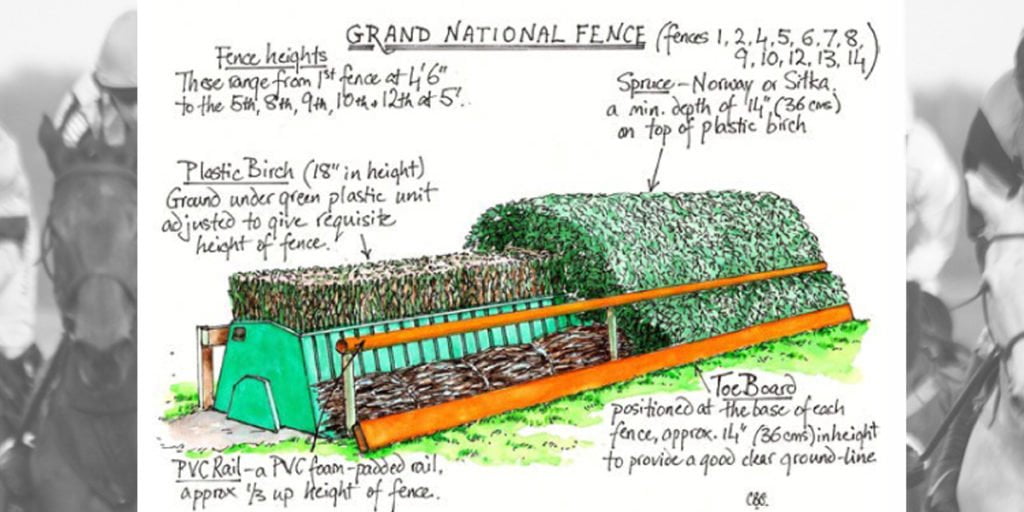[et_pb_section bb_built=”1″][et_pb_row][et_pb_column type=”4_4″][et_pb_text _builder_version=”3.0.95″ background_layout=”light”]
Image Credit: Aintree Racecourse
Rookies Guide to Racing – National Hunt (Jump) Racing: National Hunt, or Jump Racing takes place during the Winter Months in the UK and Ireland. Have a read through our Rookies Guide, to learn a bit more about what it all means!
Jump Racing tends to be made up of different types of jumps (or obstacles) and there’s a hierachy to it all that bears keeping in mind when you’re picking a horse to back. There are three different types of Races in Jump Racing: Chases, Hurdles and Bumpers.
[/et_pb_text][et_pb_image _builder_version=”3.0.95″ src=”https://www.eclipsemagazine.co.uk/wp-content/uploads/2018/01/Steeplechases-2.jpg” show_in_lightbox=”off” url_new_window=”off” use_overlay=”off” always_center_on_mobile=”on” force_fullwidth=”off” show_bottom_space=”on” /][/et_pb_column][/et_pb_row][et_pb_row][et_pb_column type=”1_2″][et_pb_text _builder_version=”3.0.95″ background_layout=”light”]
THE CHASES
The name ‘Chase’ comes from Steeplechase, which comes from jump racing’s origins in Ireland – the jockeys would race each other from one church steeple to another, jumping every obstacle in between.
These days, Chases are typically run over a distance of two to four and a half miles (that’s 3.2 to 7.2 km in new money) and the racers will encounter different types of obstacles including plain fences, water jumps and open ditches. The horses run over at least eight obstacles.
FENCE: to be considered a Fence, the obstacle needs to be at least 4.5 ft tall and rigid
[/et_pb_text][/et_pb_column][et_pb_column type=”1_2″][et_pb_image _builder_version=”3.0.95″ show_in_lightbox=”off” url_new_window=”off” use_overlay=”off” always_center_on_mobile=”on” force_fullwidth=”off” show_bottom_space=”on” src=”https://www.eclipsemagazine.co.uk/wp-content/uploads/2017/04/1SixtySomething.jpg” /][/et_pb_column][/et_pb_row][et_pb_row][et_pb_column type=”1_2″][et_pb_image _builder_version=”3.0.95″ show_in_lightbox=”off” url_new_window=”off” use_overlay=”off” always_center_on_mobile=”on” force_fullwidth=”off” show_bottom_space=”on” src=”https://www.eclipsemagazine.co.uk/wp-content/uploads/2017/03/AintreeRC.jpg” /][et_pb_text _builder_version=”3.0.95″ background_layout=”light”]
Image Credit: Aintree Racecourse
[/et_pb_text][/et_pb_column][et_pb_column type=”1_2″][et_pb_text _builder_version=”3.0.95″ background_layout=”light”]
CHASER HORSES
Horses that run in Chases tend to be older and more experienced, often having learned their trade jumping over Hurdles – the prescribed way to learn jumping technique and gain suitable racing experience. These horses are referred to as ‘Chasers’.
Chases don’t use Stalls to start the race, rather, they start from behind elasticated tapes that are stretched across the racecourse and then released when the race starts. The horses are circled by their jockeys behind the tape, only moving towards it when called in by the Starter. Once the tapes are released, the race starts.
[/et_pb_text][/et_pb_column][/et_pb_row][et_pb_row][et_pb_column type=”1_2″][et_pb_text _builder_version=”3.0.95″ background_layout=”light”]
STEEPLECHASE FACTS:
- The Grand National (run at Aintree Racecourse), the Cheltenham Gold Cup and Queen Mother Champion Chase (also run at Cheltenham) are the most famous steeplechases in the UK.
- Forty Racecourses across the UK stage Chase Races
- Amateur Steeplechasing is called Point-to-Point
- The longest chase at Cheltenham Racecourse is the National Hunt Chase
- The longest chase overall is the Grand National
[/et_pb_text][/et_pb_column][et_pb_column type=”1_2″][et_pb_image _builder_version=”3.0.95″ show_in_lightbox=”off” url_new_window=”off” use_overlay=”off” always_center_on_mobile=”on” force_fullwidth=”off” show_bottom_space=”on” src=”https://www.eclipsemagazine.co.uk/wp-content/uploads/2013/03/jycheltfest2013.jpg” /][/et_pb_column][/et_pb_row][et_pb_row][et_pb_column type=”1_2″][et_pb_image _builder_version=”3.0.95″ show_in_lightbox=”off” url_new_window=”off” use_overlay=”off” always_center_on_mobile=”on” force_fullwidth=”off” show_bottom_space=”on” src=”https://www.eclipsemagazine.co.uk/wp-content/uploads/2010/04/goldcup.jpg” /][/et_pb_column][et_pb_column type=”1_2″][et_pb_text _builder_version=”3.0.95″ background_layout=”light”]
Focus: Cheltenham Gold Cup
This race takes place on the last day of the Cheltenham Festival and is the most prestigious race of the National Hunt (Jump) Season. It tests the horses ability to run at a true gallop, running over fences at speed, and requires them to have the reserves of energy and stamina to run up the famous hill at the end of the race. This requires plenty of skill from jockeys as well, who are there to guide the horses through the race to the best of their abilities.
[/et_pb_text][/et_pb_column][/et_pb_row][et_pb_row][et_pb_column type=”4_4″][et_pb_image _builder_version=”3.0.95″ src=”https://www.eclipsemagazine.co.uk/wp-content/uploads/2018/01/Hurdles.jpg” show_in_lightbox=”off” url_new_window=”off” use_overlay=”off” always_center_on_mobile=”on” force_fullwidth=”off” show_bottom_space=”on” /][/et_pb_column][/et_pb_row][et_pb_row][et_pb_column type=”1_2″][et_pb_text _builder_version=”3.0.95″ background_layout=”light”]
THE HURDLES
Hurdle Races are run over a minimum of eight hurdles and for at least two miles (three km). Because the obstacles are lower than fences, they are typically faster than chases – allowing the horses to keep the momentum they have built up between hurdles. Hurdle races that are longer than two miles are often referred to as ‘Stayers Hurdles’ due to the amount of stamina required to run at speed over the hurdles for such a long distance.
These are the smaller fences that you’ll see at a Jump (National Hunt) course. Horses will typically spend a couple of seasons over hurdles before moving onto fences (taller and more rigid), although some horses run over fences straight away. Hurdles are shorter than Fences (being a minimum of 3.5 ft tall compared to 4.5 ft.) and are flexible, as they are constructed from a series of panels that have been made from cut brush.
[/et_pb_text][/et_pb_column][et_pb_column type=”1_2″][et_pb_image _builder_version=”3.0.95″ show_in_lightbox=”off” url_new_window=”off” use_overlay=”off” always_center_on_mobile=”on” force_fullwidth=”off” show_bottom_space=”on” src=”https://www.eclipsemagazine.co.uk/wp-content/uploads/2017/11/NewcRCFightingFifthHurdle1.jpg” /][/et_pb_column][/et_pb_row][et_pb_row][et_pb_column type=”1_2″][et_pb_image _builder_version=”3.0.95″ show_in_lightbox=”off” url_new_window=”off” use_overlay=”off” always_center_on_mobile=”on” force_fullwidth=”off” show_bottom_space=”on” src=”https://www.eclipsemagazine.co.uk/wp-content/uploads/2013/01/iyirishsaintleadingrollingstarhurdle.jpg” /][/et_pb_column][et_pb_column type=”1_2″][et_pb_text _builder_version=”3.0.95″ background_layout=”light”]
HURDLE HORSES
Often you’ll notice that Hurdlers are more petite than Chasers, as it’s not unusual for horses that previously ran over the Flat (racing with no obstacles at all) to run over hurdles. However, larger horses will often run over hurdles before they graduate to Chases, in order to gain racing experience.
[/et_pb_text][/et_pb_column][/et_pb_row][et_pb_row][et_pb_column type=”1_2″][et_pb_text _builder_version=”3.0.95″ background_layout=”light”]
HURDLE FACTS
- Forty Racecourses across the UK stage Hurdle Races
- The most famous hurdle races include The Champion Hurdle (Cheltenham), the World Hurdle (Cheltenham) and The Christmas Hurdle (Kempton Park) (Links to all available races)
[/et_pb_text][/et_pb_column][et_pb_column type=”1_2″][et_pb_image _builder_version=”3.0.95″ show_in_lightbox=”off” url_new_window=”off” use_overlay=”off” always_center_on_mobile=”on” force_fullwidth=”off” show_bottom_space=”on” src=”https://www.eclipsemagazine.co.uk/wp-content/uploads/2018/01/IYCheltenham-JCBTriumphHurdleTrialJan2017.jpg” /][/et_pb_column][/et_pb_row][et_pb_row][et_pb_column type=”1_2″][et_pb_image _builder_version=”3.0.95″ show_in_lightbox=”off” url_new_window=”off” use_overlay=”off” always_center_on_mobile=”on” force_fullwidth=”off” show_bottom_space=”on” src=”https://www.eclipsemagazine.co.uk/wp-content/uploads/2018/01/IYCleeveHurdleJan17.jpg” /][/et_pb_column][et_pb_column type=”1_2″][et_pb_text _builder_version=”3.0.95″ background_layout=”light”]
Focus: The Champion Hurdle
This is the biggest hurdle race to be run during the National Hunt season, and decides the Champion Hurdler of the year. As with the Cheltenham Gold Cup, the horses are tested not only on speed, but also on stamina, due to the final hill, just before the climax of the race. It takes place on the opening day of The Festival.
[/et_pb_text][/et_pb_column][/et_pb_row][et_pb_row][et_pb_column type=”4_4″][et_pb_image _builder_version=”3.0.95″ src=”https://www.eclipsemagazine.co.uk/wp-content/uploads/2018/01/Bumpers.jpg” show_in_lightbox=”off” url_new_window=”off” use_overlay=”off” always_center_on_mobile=”on” force_fullwidth=”off” show_bottom_space=”on” /][/et_pb_column][/et_pb_row][et_pb_row][et_pb_column type=”1_2″][et_pb_text _builder_version=”3.0.95″ background_layout=”light”]
BUMPERS
The name Bumper comes from a rather less than flattering reference to the riding style of the jockeys that used to run in this type of race. Typically they were amateurs, and their lack of skill with the horses led them to bump into each other in a way that was unacceptable to the professional jockeys. It’s evolved into an informal term for a flat race run by jump horses. These races are usually confined to younger horses (aged between four and six) and are run over distances of 1½-2½ miles.
[/et_pb_text][/et_pb_column][et_pb_column type=”1_2″][et_pb_image _builder_version=”3.0.95″ show_in_lightbox=”off” url_new_window=”off” use_overlay=”off” always_center_on_mobile=”on” force_fullwidth=”off” show_bottom_space=”on” src=”https://www.eclipsemagazine.co.uk/wp-content/uploads/2011/06/windrchorses2sml.jpg” /][/et_pb_column][/et_pb_row][et_pb_row][et_pb_column type=”1_2″][et_pb_image _builder_version=”3.0.95″ show_in_lightbox=”off” url_new_window=”off” use_overlay=”off” always_center_on_mobile=”on” force_fullwidth=”off” show_bottom_space=”on” src=”https://www.eclipsemagazine.co.uk/wp-content/uploads/2013/01/iyirishsaintleadingrollingstarhurdle.jpg” /][/et_pb_column][et_pb_column type=”1_2″][et_pb_text _builder_version=”3.0.95″ background_layout=”light”]
BUMPER HORSES
Often, running in Bumper Races is the first stage in a horse’s career development, and the races are used to give the horse racing experience before they move on to hurdles, and then possibly fences.
[/et_pb_text][/et_pb_column][/et_pb_row][et_pb_row][et_pb_column type=”1_2″][et_pb_text _builder_version=”3.0.95″ background_layout=”light”]
BUMPER FACTS
- Sometimes Flat Jockeys will apply for a Jump Jockey License to enable them to ride in Bumpers
[/et_pb_text][/et_pb_column][et_pb_column type=”1_2″][et_pb_image _builder_version=”3.0.95″ show_in_lightbox=”off” url_new_window=”off” use_overlay=”off” always_center_on_mobile=”on” force_fullwidth=”off” show_bottom_space=”on” src=”https://www.eclipsemagazine.co.uk/wp-content/uploads/2018/01/IYManyClouds_main.jpg” /][/et_pb_column][/et_pb_row][et_pb_row][et_pb_column type=”1_2″][et_pb_image _builder_version=”3.0.95″ show_in_lightbox=”off” url_new_window=”off” use_overlay=”off” always_center_on_mobile=”on” force_fullwidth=”off” show_bottom_space=”on” src=”https://www.eclipsemagazine.co.uk/wp-content/uploads/2016/02/RGCheltenham1.jpg” /][/et_pb_column][et_pb_column type=”1_2″][et_pb_text _builder_version=”3.0.95″ background_layout=”light”]
Focus: The Champion Bumper
There is only one Bumper run at Cheltenham – The Champion Bumper – and it is the most prestigious Bumper race of the season (Link to Champion Bumper)
[/et_pb_text][/et_pb_column][/et_pb_row][et_pb_row][et_pb_column type=”4_4″][et_pb_code _builder_version=”3.0.95″]<!– [et_pb_line_break_holder] –><!– START ADVERTISER: Jockey Club Racecourses Limited from awin.com –><!– [et_pb_line_break_holder] –><!– [et_pb_line_break_holder] –><a href=”https://www.awin1.com/cread.php?s=2093752&v=7677&q=309279&r=111181″><!– [et_pb_line_break_holder] –> <img src=”https://www.awin1.com/cshow.php?s=2093752&v=7677&q=309279&r=111181″ border=”0″><!– [et_pb_line_break_holder] –></a><!– [et_pb_line_break_holder] –><!– [et_pb_line_break_holder] –><!– END ADVERTISER: Jockey Club Racecourses Limited from awin.com –><!– [et_pb_line_break_holder] –>[/et_pb_code][et_pb_text _builder_version=”3.0.95″ background_layout=”light”]
Jumping for joy
As we see above, National Hunt (or Jump) racing, the horses jump either hurdles or fences. The core of the National Hunt season is run over the winter when the ground is softer and more appropriate for jumping. Sometimes you might even hear NH/Jump racing referred to as ‘racing over the sticks’ or ‘chasing’ (steeple chasing).
National Hunt racehorses are much cheaper than ‘Flat’ horses, as the majority of them are geldings and have no breeding value.
There is no doubt that Jump racing is a thrilling spectacle with horses leaping large, (almost) solid fences at great speed. It is also more unpredictable than Flat racing, as there is a greater chance of horses falling or jockeys coming off the horses – consequently this is a very dangerous sport, for the riders in particular.
Jockeys must pace the horses through the race in the same way as with Flat racing, but there is the added skill of timing the striding going in towards the Jump or hurdle: too close and the horse may catch its legs on the fence and be tipped up; too far away and it may not have enough ‘leap’ to carry it all the way over the fence.
In both Jump and Flat racing, horse and rider must work as a team, in order to make and act upon instant decisions under high pressure at a flying pace – quite a feat!
The highlights of the National Hunt calendar are the Cheltenham Festival and Aintree’s Grand National meeting, though there are plenty of other entertaining meetings as well.
Though these meetings may be more ‘tweedy’ than the Flat meetings in the dressing up stakes (unless you are determined to wear your party dress to the Grand National!) elegance and style are still high on the agenda and the occasions are highly sociable.
National Hunt is split into three racing groups:
Chase/Steeple Chase – Run over fences, over longer distances. Fences are either ‘Plain’ or include a ‘Water Jump’ or an ‘Open Ditch’.
Hurdling – Run over hurdles that are lower and less solid than fences, though horses travel more quickly over them than with ’chasing’.
Point-to-point – see below
Hurdle races and Steeple Chases are divided into different lengths between 2 and 3+ miles, and different levels of age or experience: Juvenile (young horses); Novice (for horses who have not won a race at the start of the season); and Open (for any horses). For example, a race may be a 2-mile Novices’ Hurdle Race, or a 2½-mile Open Steeple Chase, etc.
In addition, there are variations of these Jump races, which can be applied to the other race categories: Handicap, Claiming, Selling, Maiden and Apprentice (see Jargon Buster for explanation of terms). So, a race may be a 2-mile Selling Hurdle Race, or a 3-mile Novices’ Handicap Steeple Chase, etc.
For each category of race, there is an end of season Championship race; some of which are held at the Cheltenham Festival in March and the rest of which are run at the Grand National Meeting at Aintree in April.
As with Flat racing, there are different standards of Jump racing:
Pattern
These are major races that are Class 1 status for high-rating horses, sub-divided into Grades:
Grade 1 – Championship races where horses are allocated a racing weight according to their age and sex but NOT in relation to previous performances (this is called Weight-for-Age)
Grade 2 – either Weight-for-Age but with performance rating taken into account as well; or Limited Handicaps where only a small degree of extra weight can be allocated
Grade 3 – Open Handicap races with high prize money
Listed races – the next level down from Graded races, but still for horses of a high standard
Classes 2–7
All other races are divided according to the horses’ ratings (see Flat racing).
If you attend a Jump raceday and notice that (usually at the end of the day) there is a race where the horses are not actually Jumping anything, it is not because they have forgotten to tackle the obstacles. It will be a National Hunt Flat Race, or ‘Bumper’, which is a type of Jump race run for novice horses to get used to being on a racecourse before they reach the next stage of their career and have to add Jumps into the mix. In other words, a beginner Jump horses’ race (This was originally an Irish creation and was named the Bumper because not only did the horses tend to bump into each other, but the Jockeys often bumped up and down on the back of the horse!)
Making the point
Point-to-point racing is amateur racing for hunting horses. There is a big social scene attached to point-to-points, with families and friends turning up to share picnics and watch the horses.
Often the bigger point-to-points will have a market where you can buy exclusive ‘Country Living’ style goods, and there will usually be a load of entertainment laid on for the kids.
If you are going to a point-to-point, make sure you take a blanket, or something waterproof to sit on, as they tend to be in a field somewhere, and British weather being what it is, it’s always better to be prepared for anything.
However, rural as they are, the point-to-points always do a good line in beer tents and food, and the townies amongst you can be sure that they will have the odd Portaloo around as well.
Many trainers and jockeys use point-to-point as preparation for National Hunt racing. If you are looking for a relaxed day out, look for a point-to-point near you. They are fun, and a great way to enjoy racing.
[/et_pb_text][/et_pb_column][/et_pb_row][/et_pb_section]
Allison is the Publisher of Eclipse Magazine. She loves going to the Races and is learning to bet (despite being officially the worst bettor in the History of the Universe), there’s a lot more to learn…





